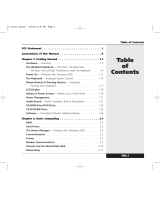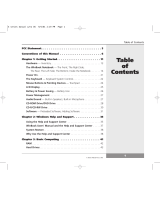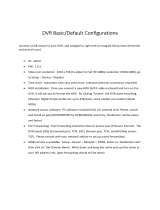Page is loading ...

D5004FH+C1030DP7*4
D5008DH+C1030DP7*4
Instruction Manual

1
1. PRECAUTIONS
Please observe the following precautions to avoid damage or data loss caused by improper
operation.
The DVR will work properly when used within the specified temperature and humidity levels.
Do not install the DVR in a dusty, humid, or smoky environment.
This device requires a stable, flat surface for proper operation.
Do not block the DVR’s ventilation openings.
Install only according to the instructions.
Do not spill liquid of any kind on this device.
Do not put any other equipment on top of this device.
Do not attempt to repair this DVR yourself, please refer all repair to a qualified technician.
Only use a Hard Disk Drive specified by the manufacturer with this DVR.
2. NOTES
This User Manual is for reference only and only applies to the products in this manual.
Updates to this manual or to the product may occur without notification.
The pictures shown may not be of the same product, and are for illustration purposes only.
Please contact Customer Service if you have any questions or want to upgrade to the latest
support software.
The default setting of the DVR is NTSC.

2
CONTENT
1. PRECAUTIONS ............................................................................................................................ 1
2. NOTEs .......................................................................................................................................... 1
3. PRODUCT INTRODUCTION ....................................................................................................... 4
3.1. Introduction ..................................................................................................................... 4
3.2. Features .......................................................................................................................... 4
3.3. Installation ....................................................................................................................... 5
3.4. Panel Introduction ........................................................................................................... 7
3.5. USB Mouse ..................................................................................................................... 8
3.6. Input Method ................................................................................................................... 8
3.7. Power On/Off ........................................................................................................... …. 9
3.8. Menu Icons.....................................................................................................................11
3.9. Live View ........................................................................................................................12
3.10. Right Mouse Menu Button .............................................................................................12
3.11. Main Menu Introduction .................................................................................................16
3.12. Main Menu > the SEARCH menu..................................................................................17
3.13. Main Menu > the CONFIGURATION menu ..................................................................20
3.14. Main Menu > the STORAGE menu ...............................................................................37
3.15. Main Menu > the OUTPUT menu ..................................................................................42
3.16. Main Menu > the MAINTENANCE menu ......................................................................46
3.17. Main Menu > the SHUTDOWN menu ...........................................................................48
4. WEB & CLIENT ...........................................................................................................................49
4.1. Web Operation ...............................................................................................................49
5. FUNCTIONs.................................................................................................................................59
5.1. DDNS Function ..............................................................................................................59
5.2. Port Forwarding..............................................................................................................64
5.3. NTP function ..................................................................................................................65

3
5.4. Voice Intercom ...............................................................................................................66
5.5. Hard Disk redundancy ...................................................................................................67
5.6. HDD S.M.A.R.T..............................................................................................................68
5.7. Updating Firmware:........................................................................................................69
5.8. Glossary .........................................................................................................................71
5.9. Hard Drive Capacity .......................................................................................................72
5.10. Common Faults..............................................................................................................75
Appendix1. Camera User Manual ......................................................................................................78

4
3. PRODUCT INTRODUCTION
3.1. INTRODUCTION
Congratulations on your purchase of the WinBook Security 8 Channel DVR Security System. The
included Digital Video Recorder (DVR) and Night Vision Cameras are an ideal solution for securing
your personal and commercial lifestyles. This DVR supports synchronized video playback and
monitoring, select network-based system controls, and several network streaming capabilities.
This manual is for both the 4/8 channel DVR models.
3.2. FEATURES
LIVE VIEW
CVBS interface, VGA /HDMI synchronous output.
COMPRESSION
H.264 video compression, G.711 audio compression, supports D1-30 fps resolution.
RECORDING
Recording modes include manual, timed, alarm, and motion detection. It supports SATA hard disks
and local disk S.M.A.R.T. technology. This DVR also supports USB backup and Internet backup.
PLAYBACK
Playback can be viewed in several ways including local and network playback, multiple channels,
and simultaneous playback. There is also support for accelerated or slow motion viewing, rewind,
and frame by frame mode. Specific time playback is also supported.
COMMUNICATION INTERFACE
Utilize USB 2.0 high-speed interface for connecting various backup devices, and a standard
Ethernet interface which works with various networks.
NETWORK PROTOCOLS
Supports TCP/IP, UDP, RTP/RTSP, DHCP, PPPOE, DDNS, NTP etc. Supports network real-time
live viewing, recording, playback, and camera control. Built-in Web Server, IE browser for direct
access.

5
3.3. INSTALLATION
3.3.1. CHECK DVR AND ACCESSORIES
Your surveillance system should include the following items. If anything is missing please accept
our apologies & immediately notify your nearest WinBook Security distributor.
• Digital Video Recorder (8 channel DVR)
• 4 x Night Vision Security Cameras
• 4 x BNC Video and power extension cable - 60ft
• 4 x Mounting Hardware Sets
• Hard Disk Mounting Hardware Packet
• AC Adapter – AC to DC 12V 5A
• 9 Way Power Splitter Cable
• 3’ RJ45 Cable
• USB MOUSE
• User Manual
• Quick Start Guide
• Support CD
3.3.2. HARD DISK INSTALLATION
Tools & Preparation
You will need a Philips-head screwdriver and a compatible Hard Disk Drive to install inside the
DVR housing.
Hard Disk Specifications: 3.5-inch SATA hard disk drive (maximum capacity is 2TB).
Installation Steps
Make sure to take precautions against static electric discharge when installing the hard disk. Static
discharge could damage the drive and the internal components of the DVR. To reduce this risk, it
is best to work on an anti-static mat and to use a grounding wrist strap.
1. Using a Philips-head screwdriver, remove the 2 Hard Drive Panel screws located on the bottom
of the DVR.
2. Remove the Hard Drive Panel and connect the power and data cables from the DVR circuit
board to your Hard Drive. Seat the drive flush into the bay with the top of the drive pointed up.

6
3. Replace the Hard Drive Panel and use the supplied screws to fasten the Panel to the DVR
frame and inserted hard disk screw mounts.
Note:
The capacity of the hard disk determines how much video can be recorded to the hard in addition
to whatever DVR parameters (recording or encoding setup) have been set to make the recording.
Refer to section 5.10 in Chapter 5 of this manual for more information.
3.3.3. SYSTEM INSTALLATION
WARNING: Do not power any electrical devices involved in installation until all video and camera
connections have been made.
Step 1: Connecting Your WinBook Security DVR to a TV or Monitor
Before connecting your DVR, please ensure the proper video ports are available on your TV or
monitor. Your model supports BNC (you may use a BNC-RCA adapter for analog purposes, VGA
and HDMI. Using the video cable of your choice, connect the video ports on your DVR and display.
VGA/HDMI Cables not included.
Step 2: USB Mouse installation
Remove the included USB mouse from its packaging and plug the USB connection into one of the
two available USB ports located on the rear of your DVR.
Step 3: Night Vision Camera Installation
NOTE: It is highly recommended to verify full operational functionality of your cameras before fixed
installation.
The included 60’ BNC video extension cables are color coded and labelled to streamline
installation. Connect the yellow BNC video cable with label “To Camera” and red power plug cable
to each camera.
Plug the “To DVR Only” BNC end of the cable into the one of the eight (8) video input ports on the
back of your DVR.

7
Step 4: Powering your devices
Cameras – Connect the red female power connection of each 60’ extension cable into the
provided power splitter.
Connect the female power splitter end into the male end of the power supply.
Plug power supply into an available surge protector or wall socket.
DVR
Plug the labelled DVR power plug into the DVR
3.4. PANEL INTRODUCTION
3.4.1. REAR PANEL
DIAGRAM 3-4(F)
Rear Panel Instruction for D5004FH

8
DIAGRAM 3-4(G)
Rear Panel Instruction for D5008DH
Index
Name
Description
1
Video input
Composite video signal (CVBS) input interface.
2
Video output
Composite video signal (CVBS) output interface.
3
HD OUTPUT
HD output interface.
4
VGA
VGA output interface.
5
Audio input/output
Audio input/output interface.
6
USB/Network
USB2.0 and RJ-45 interface.
7
Power input
DC 12V.
3.5. USING THE USB MOUSE
The included USB mouse is the optimal method to navigate with the DVR and its menus.
To access or exit the Menu Screen – Right click anywhere
To select Menu items – Left click on the desired menu item
To exit each Menu – Right click on any area outside the menu
To maximize or minimize – Double click on any live view channel
3.6. INPUT METHOD
In the input box, choose numbers, symbols or uppercase and lowercase letters. Click the left
mouse button to select value; back arrow means backspace and the “˽” is used to enter a space.
Letter Input Interface

9
DIAGRAM 3-5 LETTER INPUT INTERFACE
Number Input Interface
DIAGRAM 3-6 NUMBER INPUT INTERFACE
Special Symbols Input Interface
Diagram 3-7 SPECIAL SYMBOLS INPUT INTERFACE
3.7. POWER ON/OFF
3.7.1. POWER ON
If the DVR is installed correctly and supplied with the power adapter, the DVR will boot up
automatically.
Upon boot-up, your DVR will run through a brief diagnostics phase lasting approximately 20
seconds, an audible alarm tone will indicate successful start-up. You will then have access to the
multi-screen live view.

10
DIAGRAM 3-8 LIVE VIEW
Note: The included power supply is rated for exact use with your DVR Kit, substitution of the
device is not recommended and may void your warranty.
3.7.2. POWERING OFF
Select the SHUTDOWN option in the main menu of the DVR.
【Main Menu】→【Shutdown】→【Shutdown】.

11
DIAGRAM 3-9 TURN OFF DEVICE
NOTE: Ensure DVR is completely powered off before replacing any component, including
hard drives.
3.7.3. OUTAGE RECOVERY
If you have to reboot after a power outage or forced shutdown, the DVR will have saved any files
before the power outage occurred and will return to the normal operation mode.
3.8. MENU ICONS
3.8.1. STATUS ICONS
:Record
:Video feed lost
:Motion detected
:Channel lock
:Allows screen to switch polling
3.8.2. OPERATION ICONS
:Not selected
:Selected
:Drop down menu
:Confirm changes/Enter a menu.
:Cancel changes/Cancel entering a menu
:Set parameters
:Save parameters
:Restores factory default settings or reverts to the last set of saved parameters
:Apply – applies the current settings

12
:Copy current settings to other channels
:Enter the configuration menu
:Configures alarm, video detection and trigger processing
3.9. LIVE VIEW
Turn the DVR on to enter live view mode. The date, time, channel names or icons will be displayed
and indicate any recording or alarm statuses on-screen.
You can switch display screens by using the USB mouse.
When enabling on-screen messages for any external alarms, video loss, masking, motion
detection, or network and IP conflict alarms, the following interface should pop-up when any of
those events occur. Refer to
DIAGRAM 3-1 ALARM STATUS
3.10. RIGHT MOUSE BUTTON MENU
Click the right mouse button after entering the real-time browser interface and a drop down
menu will appear, see diagram 3-2
DIAGRAM 3-2 RIGHT BUTTON MENU

13
3.10.1. SCREEN SWITCHING
A maximum of eight channels can be displayed on one monitor screen. The operator can choose
to display one, four, or eight channels.
3.10.2. PAN/TILT/ZOOM CONTROL (OPTIONAL)
Select Output P/T/Z to set P/T/Z protocol, baud rate or address bits. For details on doing this,
refer to chapter 5.4. This feature is not available for the 8CH DVR kit.
3.10.3. COLOR SETTING MENU
The Color Setting menu adjusts a specified screen’s (single screen) image color, hue, brightness,
contrast, and saturation parameters. Set it for two time periods according to the local times
between day and night. For each adjustment, the device will automatically switch to the best video
quality. See the following Diagram 3-3 Color Setting.
DIAGRAM 3-3 COLOR SETTING MENU
【Period】 two time periods can be set to match the ambient light during day or night. This option
will automatically switch the color configuration at a set time. Make sure to check each box to
enable this function.
【Hue】 adjust the screen image color.
【Brightness】 Adjust the screen image brightness. It decreases/increases the brightness of the
screen image to make the image clearer.
【Contrast】 Adjust the black and white levels, the greater the ratio, the brighter the image.
【Saturation】 Adjust screen image color purity. The greater the value, the cleaner the screen
image appears.

14
Note: Different modes have different functions.
3.10.4. SEARCH
Refer to 3.12 Search.
3.10.5. RECORDING VIDEO
Note: You must follow these directions to configure the desired recording schedule for your DVR.
While in the live view screen, click on the 【Record】 button. This will bring up the manual
recording interface, as shown in Diagram 3-4 Recording Control.
DIAGRAM 3-4 RECORDING CONTROL (FOR BOTH 4- & 8-CHANNEL DVR OPERATION)
【Schedule】 Checking any of the numbered channels for this option will enable video to be
recorded based on unique parameters, including Motion Detection and Alarm.
【Manual】 Checking any of the numbered channels for this option will set the desired channel to
record continuously to the local hard drive.
【Stop】 Stops all channel recording.
After you have set up the channels to your desired recording settings, select the 【OK】 button to
confirm the changes, or click 【Cancel】 to exit without recording any changes.
Note: Selecting the “All” checkbox will change the recording status for all active channels.

15
3.10.6. MAIN MENU
Click the 【Main Menu】, enter a User name and password, click 【OK】 to enter the system
menu, as shown in Diagram 3-5 system Login below.
DIAGRAM 3-5 SYSTEM LOGIN
Default Users:
User Type
User Name
Default Password
Administrator
admin
123456
User
user
123456
Hidden
default
default
FORM 3-1 DEFAULT USERS
NOTE: An audible alarm will be triggered if a password is entered incorrectly three times, and
there will be a system lockout for 30 minutes after 5 unsuccessful login attempts.

16
3.11. MAIN MENU INTRODUCTION
The Main Menu has six navigable fields: Search, Configuration, Maintenance, Output, Storage,
and Shutdown.
DIAGRAM 3-6 SYSTEM MAIN MENU
【Search】 Search recorded video by type, channel, time and playback.
【Configuration】 Configure recording, motion detection, abnormalities, alarm, system, network
and user management settings.
【Storage】 Hard disk and back up management.
【Output】 Configure out P/T/Z, alarm output, serial and output modes.
【Maintenance】 Display the system log information, version information, stream statistics, and
online Users. You can also reset to factory defaults or use the automatic maintenance function.
【Shutdown】 Log off the User menu, turns off the machine, restarts the system, and switches
Users and all other operations.
Note: Hovering over a menu option will reveal a short description of the selected menu’s functions.

17
3.12. MAIN MENU > THE SEARCH MENU
You can call up the 【SEARCH】 interface through the Main Menu, as shown in Diagram 3-7
Record SEARCH.
DIAGRAM 3-7 RECORD SEARCH
1
5
2
3
4
9
8
7

18
Index
Type
Description
1
Calendar
Click a specific date to call up the recording. The list is upgraded automatically.
2
Time
Select recording search start and end time.
3
Play
Playback control: stop/play, pause, fast, slow, previous/next frame when in
pause mode.
4
Recording
mode
Choose searched recording mode, including NORMAL, ALARM & MOTION.
5
Channel
Choose a specific channel.
6
Play
Choose to play the previous or next file; choose to play the previous or next
channel.
7
List
Choose a starting time, channel, then click “search”, and a list of matching
records.
8
Backup
Click “ ”to choose a backup file in the file list box, click the Backup button;
to cancel a backup file, click “√” from the backup menu “√”.
9
Recording
List
The search list displays up to 128 video recordings. Choose a file and press
enter or double-click with the mouse to view a recording. File types: R—normal
recording, A—alarm recording; M—motion detection recording.
FORM 3-2 RECORDING SEARCH INTERFACE DESCRIPTION

19
Playback Control:
Key
Description
Remark
Video playback :
Fast-Forward
button
During playback, pressing this key,
allows you to Fast-Forward with a
number of speeds to choose from. The
Fast-Forward button can also be used
as a reverse of the Slow Motion key.
Actual play rate is based on
the version being used.
Video playback :
Slow Motion Key
During playback, pressing this key
provides a variety of slower playback
speeds to choose from. The Slow
Motion key can also be used as a
reverse of Fast-Forward.
Play/pause►/
Play/pause can also switch to normal
speed from slow motion playback.
Backward:
Backward Key
Moves the video playback a single
frame backward.
To go backwards, single click
again. To stop backward play
during normal playback, press
Rewind or single-frame
advance. Press the play
button ►/ to resume normal
playback.
Manual single
frame advance
Advance video by a single frame
forward or back by clicking either │ or
│when video is paused.
FORM 3-3 PLAYBACK CONTROL
Note:
1. The DVR playback control bar shows file playback speed, channel, time, playback progress and
other information.
2. The playback speed and rewind functions can differ between DVR versions. Please check the
DVR version you have in order to ensure successful operation.
/












